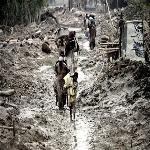02 August 2010

Photo: AP
People carry their belongings as heavy flood destroy their homes in Nowshera, Pakistan, 02 Aug 2010
The United Nations estimates the countrywide flooding in Pakistan has affected more than one million people.
It has been particularly difficult for those in the northwestern Khyber-Pakhtunkhwa Province. U.N. Office for Coordinating Humanitarian Affairs spokeswoman Nicki Bennett says the mountainous northwestern part of the country normally does not see disaster flooding.
Bennett says fortunately, many humanitarian agencies were in place there to help with the millions of people affected by the Pakistani military's ongoing offensive against the Taliban. She says the work still is not easy, though, considering this is the country's worst flooding in more than 80 years and the area's mountainous terrain can make transportation difficult, even in the best of weather.
"We have warehouses throughout all these areas; we do not have to fly in staff or fly in stocks," said Bennett. "But we were not expecting this level of problems with infrastructure and access." She says it is because of this lack of access the relief efforts have been moving slowly.
"All of the major bridges that cross the Swat River have all come down, which meant we have not been able to get to the worst affected areas," said Bennett.
Authorities say thousands of people remain stranded in villages with food and fuel running low. The Pakistani army has mobilized tens of thousands of troops, rescuing 20,000 people from marooned areas.
A number of countries are providing assistance.
The U.S. Embassy spokesman in Islamabad, Rick Snelsire, says Washington has provided $10 million immediately for relief, in addition to nearly 200,000 hilal meals, helicopters and water purification machines.
"We stand with the people of Pakistan, and are looking to be helpful in any way we can to the Pakistani people who are affected by this truly horrendous flooding," said Snelsire.
Bennett says clean drinking water is the next big concern, especially to prevent an outbreak of diseases such as diarrhea or cholera.
"We do have, you know, areas that are still standing in water," said Bennett. "There are animal carcasses, and the conditions pose a risk for those kinds of things."
A few days without rain have allowed flood waters to begin to recede, but weather forecasters predict more monsoon rains in the days to come.